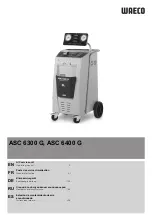
Decontaminate the sample block
Perform this procedure to eliminate fluorescent contaminants from the instrument sample block.
Contamination is generally evident in failed background calibrations where one or more wells
consistently exhibit abnormally high signals.
CAUTION!
PHYSICAL INJURY HAZARD
. Do not remove the instrument cover. There are no
components inside the instrument that you can safely service yourself. If you suspect a problem,
contact Support.
CAUTION!
PHYSICAL INJURY HAZARD.
During instrument operation, the sample block
temperature can reach 100°C. Allow it to cool to room temperature before handling.
CAUTION!
Before using a cleaning or decontamination method other than those recommended by
Thermo Fisher Scientific, confirm with Thermo Fisher Scientific that the proposed method will not
damage the equipment.
Materials required
• Safety glasses
• Powder-free gloves
• Tissue, lint-free
• Cotton or nylon swabs and lint-free cloths
• Pipette (100-µL) with pipette tips
• Deionized water
• Ethanol, 95% solution
• Bleach, 10% solution
Clean the sample block
CAUTION!
PHYSICAL INJURY HAZARD.
During instrument operation, the sample block
temperature can reach 100°C. Allow it to cool to room temperature before handling.
IMPORTANT!
Wear powder
‑
free gloves when you perform this procedure.
IMPORTANT!
Always use deionized water to rinse wells after cleaning with bleach or ethanol solution.
1.
Identify the contaminated wells of the sample block (see “Identify contamination”
).
2.
Remove the sample block and heated cover (see “Remove the block”
).
3.
Place the sample block and heated cover on a clean surface.
Chapter 10
Maintain the instrument
Decontaminate the sample block
10
QuantStudio
™
6 Pro Real-Time PCR System and QuantStudio
™
7 Pro Real-Time PCR System User Guide
159
















































